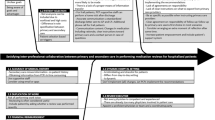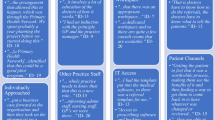Abstract
In medication review involving community pharmacists and physicians, there is an underlying assumption that if community pharmacists provide evidence based pharmacotherapeutic recommendations, physicians, in turn, will implement these recommendations. However, although in general medication review has been shown to improve the quality of medicine use, medication management plans arising from the medication review process are not always implemented. There is a need for better understanding of the factors that influence outcomes in medication review. The current paper will address some cultural and procedural factors that may assist in understanding outcomes in medication review using research into collaboration from areas outside the healthcare as a framework.
Similar content being viewed by others
References
Australian Government. Department of Health and Ageing. 2005 Domiciliary Medication Management––Home Medicines Review: Helping Your Patients Manage Their Medicines at Home. http://www.health.gov.au/internet/wcms/publishing.nsf/Content/health-epc-dmmr.htm/$FILE/dmmrguidelines.pdf (31 January, 2007).
Task Force on Medicines Partnership and the National Collaborative Medicines Management Services Programme. Room for review: a guide to medication review: the agenda for patients, practitioners and managers. Wallingford: Pharmaceutical Press; 2003.
Pharmacy Guild of Australia and Australian Divisions of General Practice Limited. 2006 Home Medicines Review: Information for Pharmacy Staff. http://beta.guild.org.au/uploadedfiles/Medication_Management_Reviews/Pharmacy/0097%20Information%20for%20pharmacy%20staff.doc (10 January 2007).
Sorensen L, Stokes JA, Purdie DM, Woodward M, Elliott R, Roberts MS. Medication reviews in the community: results of a randomized, controlled effectiveness trial. Br J Clin Pharmacol 2004;58(6):648–64.
Zermansky AG, Petty DR, Raynor DK, Freemantle N, Vail A, Lowe CJ. Randomised controlled trial of clinical medication review by a pharmacist of elderly patients receiving repeated prescriptions in general practice. BMJ 2001;323:1340–3.
Gilbert A, Roughead EF, Beilby J, Mott K, Barrat JD. Collaborative medication management services: improving patient care. Med J Aust 2002;177:189–92.
Pattison-Gordon L. Best practices in collaborative technology. http://copernicus.bbn.com/lab/oltc/papers 1997; (5 March 2000).
Vandenbosch B, Ginzberg MJ. Lotus notes and collaboration. J Manag Info Syst 1996;13(3):65–81.
Orlikowski WJ. Learning from notes: organizational issues in groupware implementation. Paper presented at the ACM, Conference on Computer-Supported Cooperative Work, Toronto, Canada, 1–4 November 1992.
Clark AS, Downing CE, Coleman D. Groupware at big six consulting firms: How successful was it? In: Coleman D, editor. Groupware: collaborative strategies for corporate LAN’s and intranets. Upper Saddle River, NJ: Prentice-Hall; 1997. ISBN 013-727728-8.
Chen TF, Crampton M, Krass I, Benrimoj SI. Collaboration between community pharmacists and GPs––impact on interprofessional communication. J Soc Admin Pharm 2001;18:83–90.
Chen TF, Crampton M, Krass I, Benrimoj SI. Collaboration between community pharmacists and GPs––the medication review process. J Soc Admin Pharm 1999;16:145–56.
Chen TF, Crampton M, Krass I, Benrimoj SI. Collaboration between community pharmacists and GPs in innovative clinical pharmacy services––a conceptual model. J Soc Admin Pharm 1999;16:134–44.
Holland R, Smith R, Harvey I. Where now for pharmacist led medication review? J Epidemiol Comm Health 2006;60:92–3.
Warkentin ME, Sayeed L, Hightower R. Virtual teams versus face-to-face teams: an exploratory study of a web-based conference system. Dec Sci 1997;28(4):975–995.
Von Krogh G, Nanaka I, Ichijo K. Enabling knowledge creation: how to unlock the mystery of tacit knowledge and release the power of innovation. Oxford: Oxford University Press; 2000. ISBN-10: 0195126165.
Handy C. Trust and the virtual organization. Harv Bus Rev 1995;73:40–50.
Rocco E. Trust breaks down in electronic contexts but can be repaired by some initial face-to-face contact. Paper presented at CHI ′98, Human Factors in Computing Systems Conference, Los Angeles, California, 18–23 April, 1998.
Author information
Authors and Affiliations
Corresponding author
Rights and permissions
About this article
Cite this article
Chen, T.F., de Almeida Neto, A.C. Exploring elements of interprofessional collaboration between pharmacists and physicians in medication review. Pharm World Sci 29, 574–576 (2007). https://doi.org/10.1007/s11096-007-9130-2
Received:
Accepted:
Published:
Issue Date:
DOI: https://doi.org/10.1007/s11096-007-9130-2




